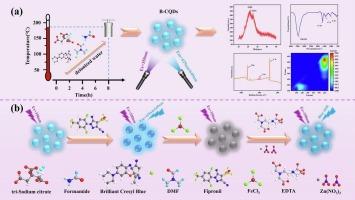Brilliant cresyl blue modified carbon quantum dots for sequential detection of insecticides fipronil, Fe3+, and acephate
IF 4.9
2区 化学
Q1 CHEMISTRY, ANALYTICAL
引用次数: 0
Abstract
Fipronil (FIP) and acephate (ACE) are highly toxic insecticides that pollute the environment and pose a health hazard, potentially being carcinogenic or teratogenic. Excess Fe3+ can trigger oxidative stress and lead to organ damage. Conventional fluorescent probes can only be used for single detection, and the development of multi-target simultaneous detection methods is imminent. In this work, brilliant cresyl blue modified carbon quantum dots (B-CQDs) were synthesized using a simple one-step hydrothermal method. It was found that B-CQDs can sequentially detect multiple substances under certain conditions. Firstly, the fluorescence of B-CQD increases with the concentration of insecticide FIP, and decreases with the addition of Fe3+. After activation treatment with EDTA and Zn2+ solutions, the fluorescence intensity of the system increases with the concentration of insecticide ACE. A fluorescent probe was established based on the above experimental phenomena to achieve sequence detection of FIP, Fe3+, and ACE, with the lower limits of detection (LODs) being 0.078 μM, 0.013 μM, and 0.055 μM, respectively. Therefore, the new method of sequence detection for multiple pesticide residues developed in this study shows great potential for application in environmental pesticide residue detection.

亮甲酚蓝修饰的碳量子点用于杀虫剂氟虫腈、Fe3+和乙酰甲胺磷的顺序检测
氟虫腈(FIP)和乙酰甲胺磷(ACE)是剧毒杀虫剂,污染环境并对健康构成危害,可能致癌或致畸。过量的Fe3+会引发氧化应激,导致器官损伤。传统的荧光探针只能进行单一检测,开发多靶点同时检测方法迫在眉睫。本文采用简单的一步水热法合成了亮甲酰蓝修饰碳量子点(B-CQDs)。结果表明,在一定条件下,B-CQDs可以连续检测多种物质。首先,B-CQD的荧光随杀虫剂FIP浓度的增加而增加,随Fe3+的加入而降低。经EDTA和Zn2+溶液活化处理后,体系的荧光强度随杀虫剂ACE浓度的增加而增加。基于上述实验现象建立荧光探针,实现FIP、Fe3+和ACE的序列检测,检测下限(lod)分别为0.078 μM、0.013 μM和0.055 μM。因此,本研究开发的多种农药残留序列检测新方法在环境农药残留检测中具有很大的应用潜力。
本文章由计算机程序翻译,如有差异,请以英文原文为准。
求助全文
约1分钟内获得全文
求助全文
来源期刊

Microchemical Journal
化学-分析化学
CiteScore
8.70
自引率
8.30%
发文量
1131
审稿时长
1.9 months
期刊介绍:
The Microchemical Journal is a peer reviewed journal devoted to all aspects and phases of analytical chemistry and chemical analysis. The Microchemical Journal publishes articles which are at the forefront of modern analytical chemistry and cover innovations in the techniques to the finest possible limits. This includes fundamental aspects, instrumentation, new developments, innovative and novel methods and applications including environmental and clinical field.
Traditional classical analytical methods such as spectrophotometry and titrimetry as well as established instrumentation methods such as flame and graphite furnace atomic absorption spectrometry, gas chromatography, and modified glassy or carbon electrode electrochemical methods will be considered, provided they show significant improvements and novelty compared to the established methods.
 求助内容:
求助内容: 应助结果提醒方式:
应助结果提醒方式:


